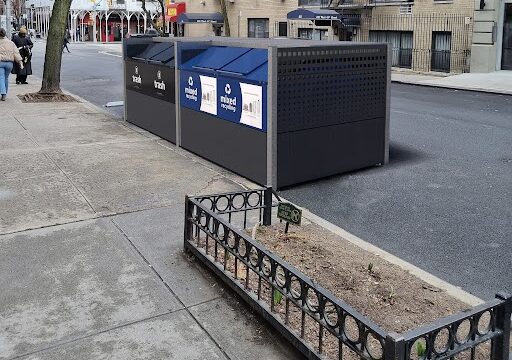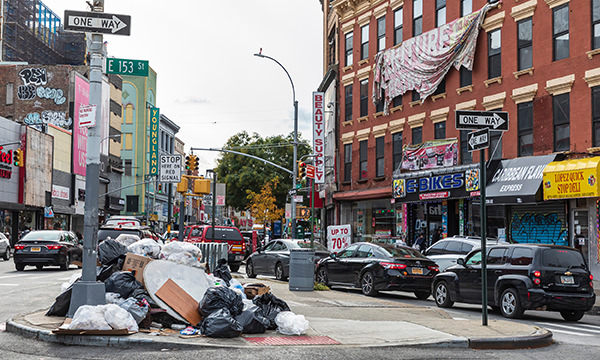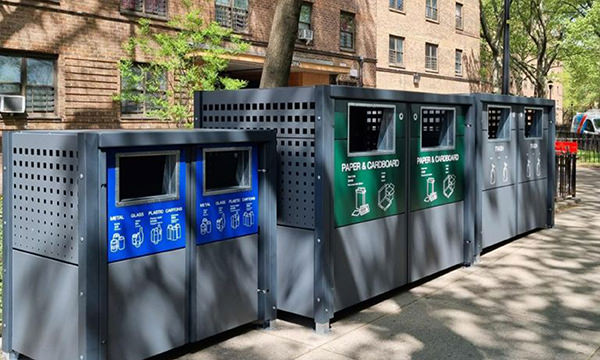

Trash & Dumpster Enclosures: A New Approach
For waste-management infrastructure across America, one of the most persistent challenges in urban environments is how to enable effective storage for household waste and recyclables as they await collection, particularly for multi-family residential settings with restricted internal space. Containerization of trash is, without doubt, the necessary transition, however, designing effective and visually presentable storage areas for trash bins and on-street dumpsters can be challenging.
Typically, trash and dumpster enclosures are designed as simple screening systems to coral a certain number of containers or dumpsters, with the main focus on providing visual concealment. While screened trash enclosures will, to some degree, address the visual aspect of untidy & overflowing garbage containers, they won’t necessarily deliver improved accessibility, vermin control, reduce trash overage and increase recycling rates through better separation of waste streams.
Modern requirements mean that traditional trash & dumpster enclosures need to offer more as waste management infrastructure. It’s also worth considering that, depending on whether the enclosure is a custom installation or purchased as a pre-manufactured solution, there are several factors that come into play that can potentially limit their suitability, such as structural considerations, access to durable materials, availability of space and flat surfacing, and environmental considerations, such as ventilation and effective drainage if the enclosure has a roofed design. There is also a likelihood that the relevant municipal organization will hold their own stipulations for an installation of this nature.
Developing a new approach to effective well-designed trash & dumpster enclosures that are visually appealing, easily accessible, and situated in prominent on-street locations, provides municipal organizations with opportunities to drive visual improvement and user-engagement within local community environments.

For a trash and dumpster enclosure system to deliver optimum effectiveness as a feature of waste management infrastructure it is crucial that the system supports the long term vision of zero waste by opening essential pathways to waste diversion targets. A new approach to trash & dumpster enclosures should make it as easy for people to dispose of trash safely and recycle correctly. Any confusion over the details of ‘mixed recycling’ often produces mixed results, limiting opportunities to achieve consistent waste diversion results.
The integration of clear, beneficial messaging helps to educate users of the correct streams, as well as color-coded graphics that coordinate with household kitchen caddies, organics carts, and commercial dumpsters at household convenience centers. Embracing these principles within A clean and compact design can help to deliver a number of benefits for municipal organizations and local communities, including:
Providing a framework that informs all product design at metroSTOR, the 5C methodology considers specific elements to help deliver solutions that address waste diversion and contamination targets for municipal organizations at local community and regional levels.

Developed specifically for a variety of use types, including outdoor trash enclosures and commercial dumpster enclosures, metroSTOR Enclosure Systems provides a highly effective, modular solution for the storage of organics, recycling, garbage, and bulky waste between collections, supporting multi-stream waste diversion strategies.
Ideal for use in multifamily, commercial or municipal drop-off centers, units can be added to form a series of enclosures for co-located waste and recycling with waste containers enclosed and bags or pails deposited directly into an open dumpster or cart through the loading aperture, removing requirements to lift heavy and dirty lids to deposit trash.
Rather than enclosing multiple containers behind a screening system, each cart or dumpster is enclosed individually within a housing designed specifically to optimise storage capacity, help increase recycling using clear signage, improve pest control and reduce the visual impact on sidewalks through the use of attractive facades.



